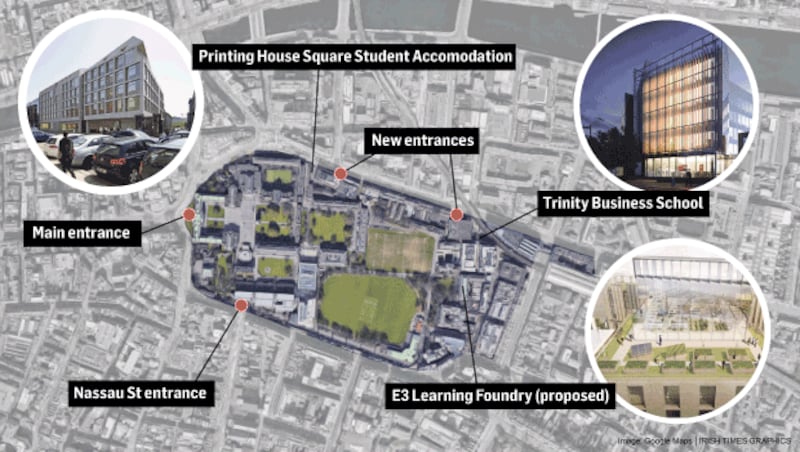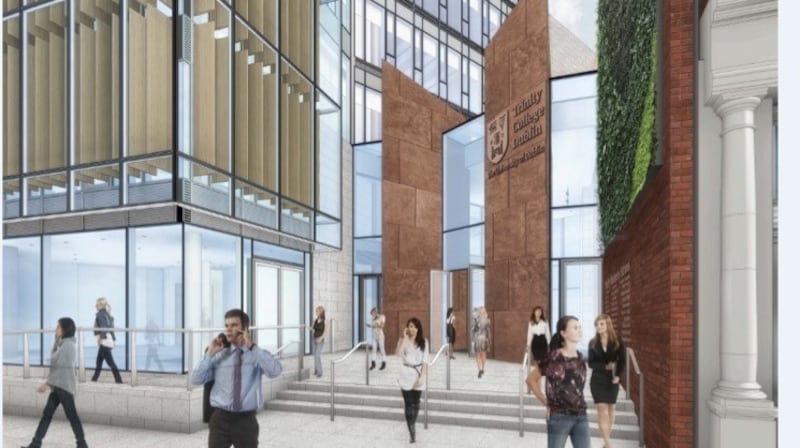For hundreds of years, Trinity College Dublin has appeared to many Dubliners as an imposing, high-walled institution they dared not enter.
"I've spoken to people who've lived and worked in the capital their whole lives," says Prof Veronica Campbell, Trinity's bursar. "Often, their first time in Trinity may not occur until they are in their 40s or 50s."
This may be about to change. A plan to modernise Ireland’s oldest university envisages opening up the campus with a series of new pedestrian entrances and forging closer links with the city around it.

There will also be a series of landmark buildings – some currently under construction – aimed at modernising ageing facilities and breathing new life into neglected streetscapes.
At the same time, there is the challenge of preserving the 426-year-old university’s historic buildings, plonked right in the heart of the capital city.
"For a 600-year period, Oxford and Cambridge vetoed the establishment of other universities in England. Trinity was the only other university to be established by royal charter," says Prof Campbell.
“What distinguishes Trinity further is that we have a campus with architecture of such monumental scale compared to the colleges of Oxford and Cambridge . . .
“We have two million visitors a year who enjoy the campus or sit out with their sandwiches in the summer.We want our university to be a place that people walk around. It’s a balancing act we need to strike, due to security, litter and so on.”
Pearse Street
A criticism regularly levelled at the college is that it has turned its back on much of the city.
The university started out as an enclosed campus and some surrounding streets have suffered as a result, such as the bleak and neglected section of Pearse Street close to the city centre.
Change is coming: the new €80 million Trinity Business School is taking shape on Pearse Street, which will include a pedestrian entrance and public cafe.

Further down the street, closer to the city centre, work is under way on the €62 million Printing House Square development, which will provide 250 student rooms over a health and sports centre. It will also feature a new public gateway into a new “public city square”.
A new law school building – still at a concept stage – may also be housed on the street over the coming years.
“Pearse Street is a challenging street with the volume of traffic, but it’s one we’ve invested in,” says Prof Campbell.
“The Science Gallery has been enormously successful . . . the business school will be a great addition and the Georgian houses will have a new cafe facility that opens directly on to the street. These are tangible improvements that will really improve the retail offering.”
Upgrading facilities to adapt to the changing way students learn will also feature in new developments.
The days of the draughty lecture theatre are numbered, it seems. The college's new E3 Learning Foundry – an engineering, energy and environment institute – will instead have "maker spaces" which allow students to work together on industrial techniques and processes; and informal learning spaces, where students can collaborate on projects.

“Empirical evidence is emerging of a positive correlation between time spent on campus and academic performance,” says Prof Campbell.
“If we’re providing a good quality experience on campus, students will want to spend time here and do their informal learning, which is an important part of the modern curriculum.”
The university is also planning to expand eastwards with the development of a €1 billion campus on Grand Canal Quay where it owns a 2.2 hectare (5.5 acre) site, though it is likely to take several years for these plans to be finalised.
Construction funding
Despite the fast pace of development, it comes at a time when higher education institutions say they are facing a growing funding crisis.
Yet, there are no fewer that four construction cranes on the horizon of Trinity. So, where’s all the money coming from?
Prof Campbell says most new activity is funded exclusively from philanthropy, borrowing and private income generated by international students and other sources.
The new E3 facility will involve €50 million in State funding, though this is the exception.
“If we relied on exchequer funding we couldn’t realise our ambitions,” she says.
“The other challenge is funding the refurbishment of our existing infrastructure and we haven’t had any exchequer support for that in recent years.”
Trinity – like other third-level colleges – will need to expand over the coming years.
Demographic trends indicate that numbers in higher education will swell by about 20 per cent over the coming decade.
Trinity, which has about 18,000 students, is planning to grow by 3,500 over the next few years.
“We need to have the appropriate facilities for accommodating students and staff,” says Prof Campbell.
“We can’t pack them in like sardines – that’s not a quality education experience – and then we need to make sure we have sufficient staff of the appropriate calibre to train and interact with students.
“There are significant resource implications in how we manage the size of the university of the future.”




















